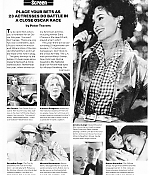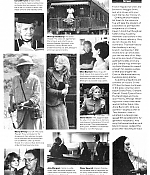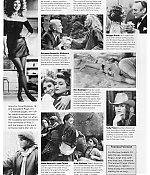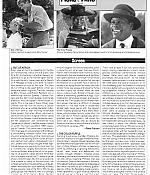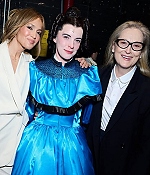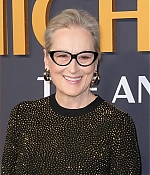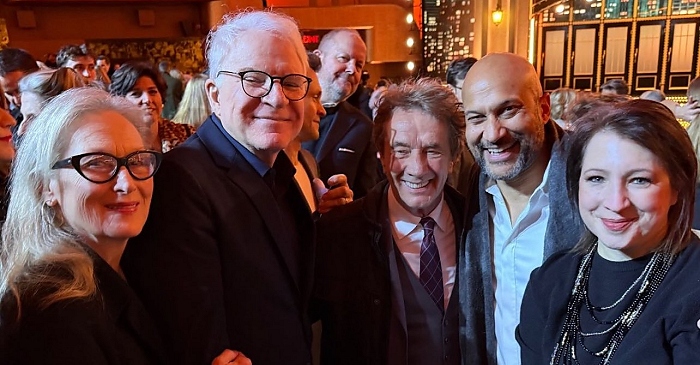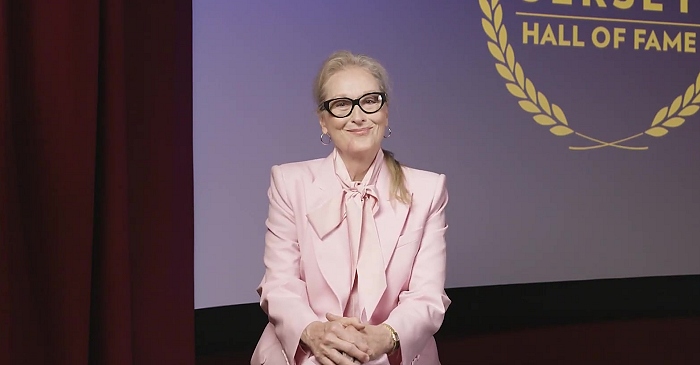|
Simply Streep is your premiere source on Meryl Streep's work on film, television and in the theatre - a career that has won her the praise to be one of the world's greatest working actresses. Created in 1999, we have built an extensive collection to discover Miss Streep's body of work through articles, photos and videos. Enjoy your stay.
|
Celebrating
25 years
of SimplyStreep
|
|
Isak Dinesen / Review: Out of Africa
People Magaznie ·
February 03, 1986
· Written by J.D. Reed
|
Isak Dinesen would surely have loved the film Out of Africa. If Sydney Pollack’s screen version of the Danish author’s best-known work takes frequent liberties with the truth about her years on a Kenya coffee plantation, omitting important aspects of her life and soft-focusing others to achieve a heightened sense of drama and romance, so much the better. Dinesen’s own Out of Africa, begun in 1936, five years after she returned to Denmark, is hardly nonfiction. She once wrote, “A poet’s mission is to make others confound fiction and reality in order to render them, for an hour, mysteriously happy.”
On the 100th anniversary of her birth—she died in 1962—Dinesen herself remains a compelling enigma that even Meryl Streep’s sensitive screen portrayal fails to illuminate. One reason is that none of the writer’s creations was more artfully contrived than her own larger-than-life persona. Though her tombstone in Denmark bears only her unadorned married name, Karen Blixen, she loved being addressed as “Baroness,” the title that came with her marriage. On her sole trip to the U.S., at age 73, she affected stark white makeup and turbans. A fragile figure weighing no more than 85 pounds, she often needed constant support. The ravages of syphilis, contracted in 1914 from her philandering husband, Baron Bror von Blixen-Finecke, had returned to affect her spine.
But the modern Scheherazade recited her acclaimed tales to mesmerized American audiences with astonishing energy and aristocratic chic. She rarely turned down an invitation, once, as legend has it, dancing on a table at a well-lubricated party with Marilyn Monroe. She was a chain-smoker whose usual dinner consisted of a few oysters, grapes and champagne. The excesses seemed an expression of one of her favorite mottoes: “To set sail somewhere is more important than life itself.”
Karen Blixen’s life was neatly separated between her 17 years in Africa and the following three decades, during which she became one of the 20th century’s greatest artists. When Ernest Hemingway accepted the 1954 Nobel Prize for literature, he told the audience that another author was more deserving—”that beautiful writer, Isak Dinesen.” She never won the prize she so richly deserved, but her haunting, magical books, which she wrote in English, are, thanks to the film, enjoying a well-deserved revival.
Karen’s art concealed a complicated inner life that was often at odds with her image. This is nowhere more dutifully revealed than in Judith Thurman’s exquisite 1982 biography, Isak Dinesen: The Life of a Storyteller, on which the film is partly based. Karen was born in 1885, the second of five children, at Rungstedlund, the Dinesen family home north of Copenhagen. Her mother, Ingeborg, came from a line of self-made millionaires, Unitarians, feminists and dour nonconformists. Her father, Wilhelm, was an officer, a gentleman and a hell-raiser famous for his sexual escapades. Before Karen’s birth he traveled to frontier America, where he hunted for a time with the Pawnee Indians. During his travels, his family came to believe, he contracted syphilis. Back home, he taught his favorite child the pleasures of a man’s world, a deep appreciation of nature and instilled in her a love of adventure and literature. But a month before Karen’s 10th birthday, Wilhelm hung himself, perhaps because he could not face a life of suffering and madness, the Victorian legacies of syphilis.
Karen’s sojourn in Africa, her fascination with the exotic and her relationships with men were shadowed by Wilhelm. Although she was a feminist when the mood took her, she would often say that what one was truly worth “lies with the opposite sex.” Like Wilhelm, she shunned conventionality. “All my life I have felt a hearty dislike of a one-man dog,” she wrote, “and of a one-woman man.”
No one could have suited that taste better than Bror Blixen. The Swedish nobleman was a refreshing change from the earnest young men who took her to the opera in Paris, where she had gone to study drawing. Bror was a renowned spendthrift and squanderer of sexual favors. He later became the model for Robert Wilson, the adulterous white hunter in Hemingway’s story The Short Happy Life of Francis Ma-comber. With $80,000 advanced by Karen’s mistrustful family, Bror preceded her to Kenya and bought a 700-acre dairy farm. But attracted by the romance of Kenyan coffee, then much in demand throughout the world, he quickly traded the farm for 4,500 acres of coffee trees in the Ngong Hills.
In 1913, at 28, sable-haired Karen departed for Mombasa by steamer, along with her grandfather’s library, a Scottish deerhound named Dusk and a huge reserve of hope. She and Bror were married by the district commissioner. They set off for Nairobi by train, ate their wedding supper in the dining car with Prince Wilhelm of Sweden and slept the night on the banquettes, after toasting themselves with champagne in the intense heat. Like the trip itself, the marriage teetered between overwrought chic and sexual disillusionment.
The greatest love of Karen Blixen’s life was not a person but a place. Her Kenya seems now an unimaginable Eden. A mere 1,000 white farmers owned an astonishing 4.5 million acres of land surrounded by 3 million natives. The plains around Nairobi, then a dusty village of tin-roofed shacks and stores, teemed with flamingos, elephants, eland and lions.
From Mbogani House, her airy stone residence set on a sweeping lawn, Karen became an avid big-game hunter, a passion that surprised her, and one that formed the basis of her work as a writer. The evocative descriptions in Out of Africa make it one of the century’s most powerful pastoral memoirs. She wrote of elephants “pacing along as if they had an appointment at the end of the world,” and of a lion “crossing the grey plain on his way home from the kill, drawing a dark wake in the silvery grass, his face still red up to the ears.” Africa was both her mirror and refuge. “The grass was me,” she wrote, “and the air, the distant visible mountains were me, the tired oxen were me.”
The people of Africa entered her heart. “They came into my life as a kind of answer to instincts deep down in the mind,” she explained. Karen shared with the Africans a belief in mystery and an acceptance of fate, a relationship that unlocked her creativity. “There was a time,” she later told a friend, “when all things in Africa, and Africa itself, said one and the same thing to me: Trust in us and we shall protect you.’ ”
Farah Aden, an East African of Karen’s own age and height, handled her accounts, cars and stables and was perhaps her closest friend. For 17 years he followed her everywhere, carrying her cashmere shawl and her loaded rifle, and stood silently in the corner when she wrote. He knew, she said, “all I did or thought.” There were, inevitably, rumors about the depth of that relationship, but it is unlikely that it was ever romantic.
The African idyll became a nightmare when Bror, who sported with Masai women on safaris, infected Karen, then 29, with syphilis. She suffered the rest of her life from bouts of excruciating spinal pain, impaired balance and anorexia nervosa later complicated by ulcers. She endured two operations to ease her suffering and used amphetamines to counter her lethargy and depression. At first she was shaken by sadness and jealousy, but years later, after her divorce, she made a bitter peace with her condition. She told a friend, “If it didn’t sound so beastly, I might say that it was worthwhile having syphilis to become a baroness.” A believer in divine balance, she also felt the disease was the price she had to pay for the gift of storytelling.
In Out of Africa, Karen made her lover, Denys Finch Hatton, the Oxford-educated son of an earl, into a kind of silent-movie hero. She portrayed him as an imperially slim, balding he-man, a hunter, farmer and pilot who shared her love of opera and taught her classical Greek. He was also a successful import-export trader and landowner who lived in one of Nairobi’s most elegant mansions. Their affair blossomed into an upper-class ménage à trois. Bror and Denys, who remained friendly, timed their safaris so that they could alternately use the same bedroom at the farm, and Bror once introduced Denys at a party as “my wife’s lover, Finch Hatton.”
To please Denys, who loved to hear stories told aloud, Karen became a subtle, evocative tale-teller who teased and seduced with her voice. During their evenings together at the farm, the couple would retire to the softly lit library, where opium and hashish here sometimes served along with the coffee. Sitting on a leopard-skin rug by Denys’ knee, or propped on pillows, Karen recited stories she had made up during his absences, honing her style and perfecting her English—the language of white Africa, of her lover and eventually of her writing.
As the relationship intensified she argued with Denys over his infidelity. Although they agreed to run “parallel” to each other, sexually free like African animals, Karen often confronted him over his other affairs, particularly one with the English pilot and horse trainer Beryl Markham, who looked like Greta Garbo and flew spotting missions for Denys’ safaris. After one bitter argument in 1931, the despairing Karen slashed her wrists in a nearly successful suicide attempt. Days later, Denys was killed when his Gypsy Moth plane crashed, and Karen’s life seemed to collapse as well.
For some time the Karen Coffee company had been losing the money invested by her relatives and friends. Although Karen stalled, borrowed and fought to keep what had become a 6,000-acre feudal fiefdom, it was finally auctioned off. The Nairobi developer who bought it wanted to create a suburban haven called “Karen” and offered the Baroness a substantial piece of land for her house. “I would prefer to live in the middle of the Sahara desert,” she disdainfully replied, “than on 20 acres in the suburb of ‘Karen.’ ”
Returning to the family home in Denmark, Karen, then 46, took stock of the shambles of her life: She would devote herself to writing. Over the remainder of her life she produced an astonishing body of work, from Seven Gothic Tales (1934) to Shadows on the Grass (1961), on a battered typewriter she had brought from Africa.
Her stories brim with a quiet and mystical exuberance. The critic Glenway Westcott aptly called Out of Africa, her second book, a “ravishingly written love potion.” Although her other tales of medieval kings and modern commoners, Christian rituals and gypsy miracles, ran counter to the fashionable social realism of Hemingway and F. Scott Fitzgerald, they were immediate successes. Five of them were chosen by the Book-of-the-Month Club, a selection she naively believed was due to their literary excellence.
Although her success brought comfortable royalties, she often haggled over servants’ wages and did not install indoor plumbing at Rungstedlund until 1960. When the spinal pain was so bad that she could not stand up, she lay on the floor and dictated stories to Clara Svendsen, her former maid who became confidante, secretary and executor of her literary estate. “Let’s work just one more hour,” she would plead. As her fame increased, the young came to her for advice about writing. It was simple and severe: “Write because you owe God an answer.”
Ultimately Karen became a calculating eccentric. “She had a fixed idea of what an Isak Dinesen tale should be, an Isak Dinesen conversation, interview, pronouncement,” said a friend. “In a funny way [Isak Dinesen] became a brand name.” Karen loved to air her 19th-century views of honor, duty and politics, and when her hair fell out from arsenic treatments for syphilis, she affected turbans and monk’s cowls. She gave her dresses psychologically appropriate names like “Sappho” and “Sober Truth.” She befriended John Gielgud when he starred in a Stratford production of The Tempest, and met H.G. Wells and Aldous Huxley. In 1960 she turned down Timothy Leary’s offer of peyote, because she was “filled with enough fantasies.”
Indeed she was. Suffering the megalomania she had always feared would accompany her illness, she played dowager queen, by turns cranky and enthralling. A favorite parlor game was to make guests name the person they’d most like to spend the night with. Some of her own choices: Stalin (“You’d never know what he was capable of”) and itinerant Scottish poet Robert Burns because, she thought, he would always be leaving.
In her 60s she tried to groom a spiritual lover into the heroic image of the long-departed Denys. Karen tried throughout a four-year involvement to get Danish poet Thorkild Bjørnvig to swear an oath that he would give her his soul in return for her instruction in art. She once waved a pistol at him to dramatize her loneliness. Later, she sat by his bed in her house and played Tchaikovsky on the phonograph while he went to sleep, as she had done for Denys in Africa.
In her final years doctors found her as wasted as a concentration camp victim. Karen joked that she had finally become “the thinnest person in the world.” She mugged for Peter Beard’s camera and made visitors trudge up a hill to see her grave site. Age had softened her attitude toward her late husband. If there was one thing in life she would like to do over, she said, it was to be in Africa again, “on a safari with Bror Blixen.” The official cause of her death: emaciation. “All sorrows can be borne,” she once wrote, “if you put them into a story.” It was an exercise she performed often and brilliantly.

